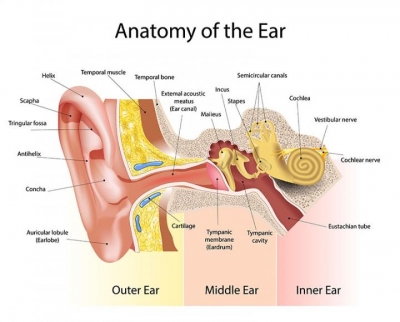
Pinna (outer ear)
The pinna is the only visible part of the ear (the auricle) with its special helical shape. It is the first part of the ear that reacts with sound. The function of the pinna is to act as a kind of funnel which assists in directing the sound further into the ear. This flap channels sounds into the ear canal.
Ear canal
The ear canal, also called the external acoustic meatus, is a passage comprised of bone and skin leading to the eardrum. The ear is comprised of the ear canal (also known as the outer ear), the middle ear, and the inner ear.
Eardrum
The eardrum is a thin, film, about 9 mm (0.4 in) wide, which sits at the entrance to the middle ear and vibrates when sound waves hit it. The eardrum also helps to stop debris from getting inside the ear and damaging it.
Hammer (malleus)
Vibrations from the eardrum are picked up by this bone. The malleus is a bone situated in the middle ear. It is the first of the three ossicles, and attached to the tympanic membrane. The head of the malleus is the large protruding section, which attaches to the incus. The head connects to the neck of malleus, and the bone continues as the handle of malleus, which connects to the tympanic membrane. Between the neck and handle of the malleus, lateral and anterior processes emerge from the bone.[2
Stirrup (stapes)
The tiny stirrup bone vibrates and moves the oval window in the cochlea. If the stapes becomes damaged, such as from severe head trauma, a person may lose some or all of their ability to hear. Because the ossicles are a chain of bones, this also holds true for the incus and malleus.
Semicircular canals
These three fluid-filled tubes contain sensors that detect movement. Your semicircular canals are three tiny, fluid-filled tubes in your inner ear that help you keep your balance. When your head moves around, the liquid inside the semicircular canals sloshes around and moves the tiny hairs that line each canal
Cochlea
The snail-shaped cochlea is filled with liquid and lined with tiny hair cells that detect vibrations. The cochlea interacts with the middle ear via two holes that are closed by membranes: the oval window, which is located at the base of the scala vestibuli and which undergoes pressure from the stapes (see ‘middle ear’), and the round window, which seals the base of the tympanic membrane and is used to relieve pressure.
Hair cells
Each hair cell in the cochlea is topped by groups of microscopic hairs. Incoming vibrations bend the hairs by different amounts. These vibration patterns are turned into nerve messages and sent to the brain.
Anvil (incus)
The incus lays at the center of the ossicles, connecting the malleus to the stapes. It is shaped like an anvil, which is why ‘the anvil’ is a widely used alternative name for the bone. Vibrations from the hammer to the stirrup are transmitted through the anvil.
Smallest bones
The ear contains three of the tiniest bones in the human body. The stirrup bone is the smallest of all, at about the size of a grain of rice.
Picture Credit : Google

